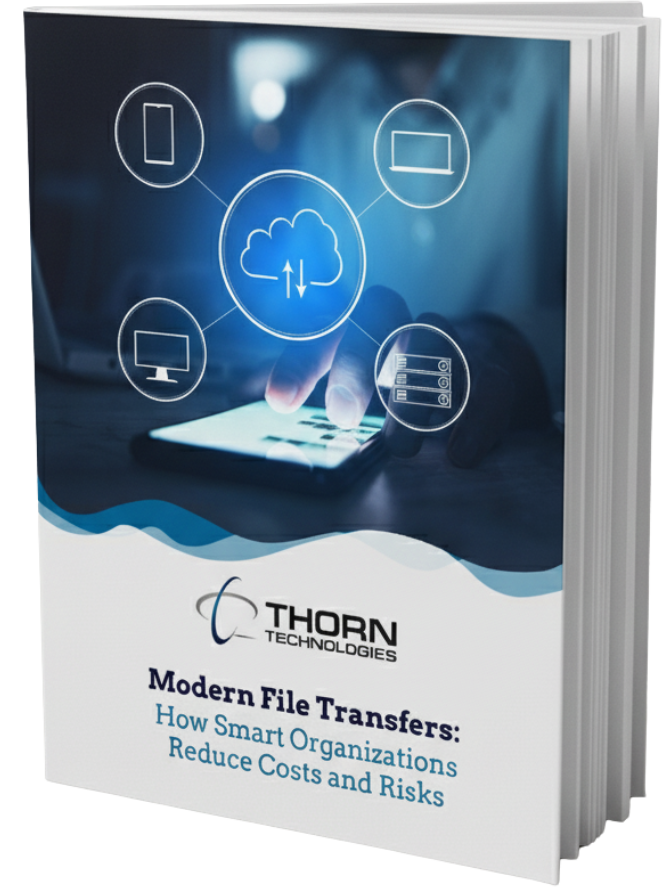Organizations worldwide are discovering a painful truth: their legacy managed file transfer (MFT) solutions are becoming expensive liabilities rather than operational assets. If your file transfer costs keep climbing while your flexibility keeps shrinking, you’re not alone, and there’s a better way forward.
The Hidden Costs of Legacy MFT Systems
Traditional managed file transfer platforms seemed like the right choice years ago. They promised enterprise-grade security, compliance features, and reliable file movement across your organization. But as your business has evolved, these legacy systems have revealed their actual cost structure.
Most legacy MFT solutions charge based on volume, connections, or both. What started as a manageable line item has quietly grown into a budget concern. Every new trading partner, every additional integration, and every scaling requirement triggers another pricing conversation with your vendor. You’re locked into proprietary protocols and vendor-specific features that make migration feel impossible.
Beyond direct costs, legacy MFT creates hidden drains on your resources. Your IT team spends hours maintaining complex configurations, troubleshooting compatibility issues, and working around inflexible architectures. Security patches lag behind modern threats. Integration with cloud services requires expensive middleware. And when you need to scale quickly, whether for seasonal demand or business growth, your legacy system becomes the bottleneck.
The Modern Alternative: Cloud-Native File Transfer
The shift to cloud infrastructure has fundamentally changed what’s possible with file transfer operations. Modern solutions leverage native cloud services, providing the security and reliability you need without the vendor lock-in and escalating costs you don’t.
We’ve created a comprehensive guide that shows you exactly how to make this transition. Our new six-page resource, Modern File Transfers, walks you through the strategic and technical considerations for moving away from legacy MFT.
Our team can talk through:
- The warning signs that your current MFT solution is holding you back.
- How cloud-native file transfer reduces costs compared to legacy platforms.
- Security considerations that actually improve when you modernize.
- Migration strategies that minimize disruption.
- Comparisons between legacy and modern approaches.
Download your free Modern File Transfers guide and see why hundreds of enterprises are making the switch.
Real-World Impact: File Automation for Enterprise Fintech
Theory is helpful, but nothing beats seeing modern file transfer in action. Consider the case of a fast-growing fintech company that hit the limits of its legacy approach.
This organization provides AI-powered spend analytics to global enterprises, offering sophisticated financial insights that rely on reliable, automated data ingestion. They serve 160 users across Europe and North America, processing client uploads that require immediate analysis through AWS Lambda functions. Their requirements were precise: complete automation, documented uptime guarantees, and seamless multi-region scaling.
Their legacy MFT system couldn’t deliver the expected results. Manual intervention was required too often. Scaling to new regions meant painful procurement cycles. Integration with their Lambda-based analytics pipeline required expensive middleware that introduced failure points.
The solution? SFTP Gateway created a fully automated pipeline that directly transfers SFTP uploads to Lambda-triggered analytics. Files uploaded to SFTP endpoints are immediately triggered to process workflows. Multi-region deployment became straightforward. AWS SLAs, rather than vendor promises, could back uptime commitments. And the total cost of ownership dropped dramatically.
The technical architecture is surprisingly elegant: SFTP Gateway sits between client uploads and your cloud infrastructure, translating traditional SFTP protocols into native cloud storage operations. From there, event-driven architectures take over—Lambda functions, Step Functions, or any other cloud services you need. You get the protocol compatibility your partners require with the automation and scalability your business demands.
Read the complete File Automation for Fintech use case to see the specific architecture and results.
When File Transfer Becomes a Competitive Advantage
Here’s what changes when you modernize your file transfer infrastructure:
Speed to market accelerates. New trading partner integrations that used to take weeks now deploy in days. Your development team can spin up new file transfer endpoints for testing without procurement approval. When business opportunities require rapid scaling, your infrastructure keeps pace.
Operational costs drop significantly. You pay for what you use, not for theoretical capacity. There are no per-connection fees, no annual maintenance escalations, and no forced upgrades to access bare security patches. Your cloud provider’s SLA becomes your uptime guarantee.
Security posture improves. Modern cloud providers invest billions in security infrastructure that legacy MFT vendors can’t match. You get encryption at rest and in transit, detailed audit logs, and integration with enterprise identity systems. Compliance frameworks like SOC 2, HIPAA, and GDPR become easier to maintain, not harder.
IT resources are freed up. Your team stops maintaining aging infrastructure and starts building business value. Integration with other cloud services becomes straightforward, while monitoring and troubleshooting leverage familiar cloud-native tools.
Going Deeper: Enterprise Architecture Considerations
If you’re evaluating this transition seriously, you need more than case studies—you need technical specifications.
Our white paper, “SFTP Gateway for the Enterprise,” provides the architectural deep dive your team needs to evaluate modern file transfer solutions. You’ll find:
- Complete infrastructure requirements and deployment patterns
- Security architecture and compliance considerations
- Integration approaches for standard enterprise systems
- Performance benchmarks and scaling characteristics
- Migration strategies for different legacy MFT platforms
- Total cost of ownership models with real-world data
Download the SFTP Gateway for the Enterprise white paper for the complete technical specifications.
Your Next Step: See It in Action
Reading about modern file transfer is valuable. Seeing it work with your specific requirements is transformative.
We offer detailed technical demonstrations of both SFTP Gateway and StorageLink, tailored to your specific use case. Whether you’re processing financial data, exchanging healthcare records, managing supply chain documents, or handling any other file transfer requirement, we’ll show you exactly how modern solutions address your specific challenges.
Schedule your personalized demo and bring your questions. We’ll walk through your current architecture, discuss your pain points, and show you what’s possible when file transfer infrastructure evolves beyond legacy constraints.
The Cost of Waiting
Legacy MFT systems aren’t getting cheaper or more flexible. Every month you wait is another month of escalating costs, limited scaling, and IT resources dedicated to maintenance rather than innovation.
Meanwhile, your competitors are likely already making this transition. They’re moving faster, spending less, and building file transfer operations that flex with business needs rather than against them.
The question isn’t whether to modernize your managed file transfer infrastructure—it’s how quickly you can make the move and start capturing the benefits.
Start with our free Modern File Transfers guide. See the specific cost comparisons, understand the security implications, and develop your migration roadmap. Then, explore the fintech use case to see the solution in action and refer to the enterprise white paper for technical depth.
When you’re ready to move from research to implementation, we’re here to help.
Your file transfer infrastructure should drive business value, not drain resources. Let’s make that happen.
About Thorn Technologies
Thorn Technologies specializes in cloud-native file transfer solutions for enterprises transitioning away from legacy MFT systems. Our SFTP Gateway and StorageLink products serve organizations worldwide, delivering the security and reliability of traditional managed file transfer solutions with the flexibility and cost efficiency of modern cloud infrastructure.
Learn more on YouTube. Let’s get started on freeing you from the rising costs of legacy MFT systems.


